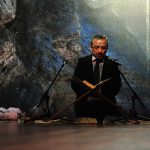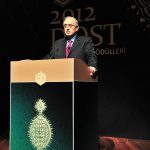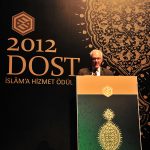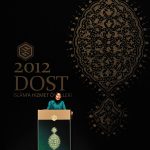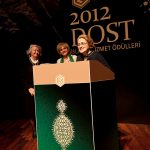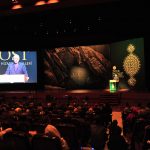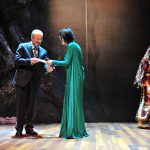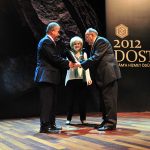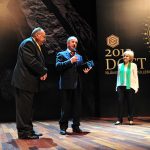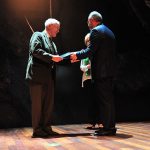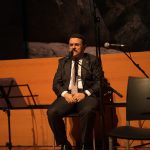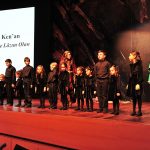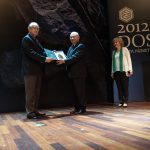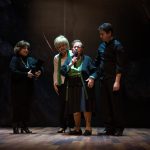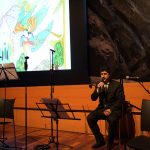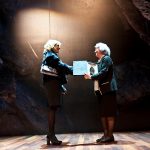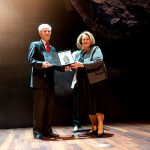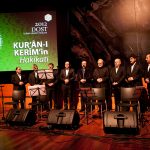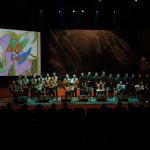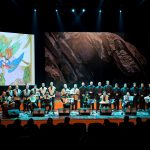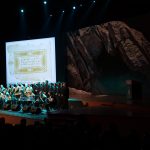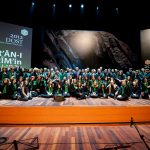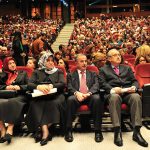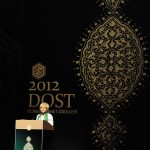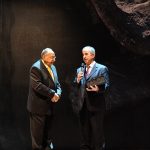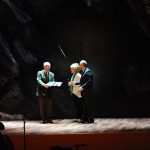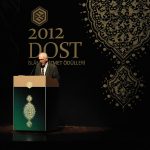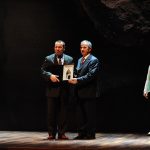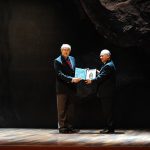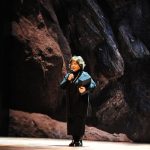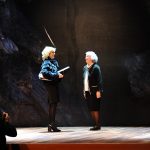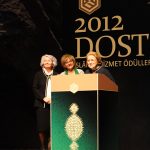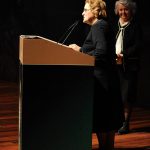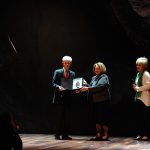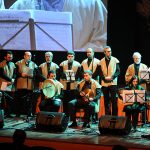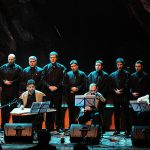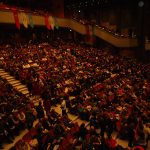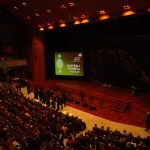The organization is open to general participation and free of charge www.nefesyayinevi.com and www.turkkad.org live on their website.
Program:
Opening Speech on behalf of Foundations
Speech by our President of Religious Affairs, Mr. Mehmet Görmez, on "The Truth of the Holy Qur'an".
Award presentations
- Search
- "La Edri" Sufi Music Concert
- Ali Bardakoglu
- Bruce Bennett Lawrence
- Elmalılı Muhammad Hamdi Yazır
- Tayyar Altıkulaç
- Calligrapher Aziz Efendi
- Mehmed Muhsin Demironat
- Islam Seçen
He was born in 1952 in Tosya/Kastamonu. In 1964, he graduated from the middle part of Çorum Imam Hatip School and in 1970 from the high school part of Istanbul (Fatih) Imam Hatip School. He graduated in 1974 from Istanbul Higher Islamic Institute and in 1975 from Istanbul University Faculty of Law.
After working as a teacher at Şişli Secondary School for a while, Ali Bardakoğlu completed his internship as a judge at the Istanbul Courthouse and worked as a judge in Afyon-Bolvadin.
In 1977, he became an assistant in Fiqh (Islamic Law) at Kayseri Higher Islamic Institute. In 1982, he completed his doctorate at Atatürk University, Faculty of Islamic Sciences, Chair of Islamic Law and was appointed as an assistant professor of Islamic Law at Erciyes University, Faculty of Theology. In 1986, he became an associate professor.
Ali Bardakoğlu joined the Faculty of Theology at Marmara University in 1993 and became a professor in 1994 and held administrative positions at the faculty.
He worked in the UK in 1991-1992 and in the United States of America in 1994.
He has published scientific publications, presented papers and organized scientific meetings on the main problems of Islam and Islamic law in the historical process and today.
Ali Bardakoğlu was appointed the 16th President of the Republic of Turkey on May 28, 2003. He was appointed as the President of Religious Affairs. During his tenure, he paid special attention to ensuring that the Diyanet addressed all segments of society in a warm and embracing language. During his presidency, the national and international mission of the institution was strengthened, the role of women in the institution and religious services increased, and the importance of knowledge and ethics in the healthy development of religiosity was emphasized.
On November 8, 2010, Ali Bardakoğlu retired and continues his scholarly work at the Islamic Encyclopedia of the Religious Foundation of Turkey.
Personal:
Born: August 14, 1941, Newton, N.J.
Website: www.duke.edu/web/muslimnets/mcw_bio/ bruce/index.htm.
Education:
1958-62 Princeton University, A.B. (magna cum laude)
1964-67 Episcopal Theological Seminary, M. Div.
1967-72 Yale University, Ph.D. (History of Religions: Islam and Hinduism)
Main Research Interests:
Comparative Research of Religious Movements
Institutional Islam, especially Indo-Persian Sufism in Asia
Religious Masks of Violence
Contemporary Islam as an Ideology of Monotheistic Faith and Religion
Muslim Cosmopolitanism and the Role of Minorities
Professional Positions and Honorary Degrees:
1971-73 Assistantship, School of Religion, Duke University
1973 Transfer to civil service (after rejecting an offer from Columbia University)
1973-79 Associate Professorship
1976-78 Head of Department, Comparative Studies in South Asia Program
1979 Professorship
1982-83 Head of Department Religious Studies, Graduate Program
1987-88 Head of Department, Faculty of Religion
1990-91 Head of Department, Faculty of Religion
1992-97 Director, Comparative Field Studies Program
1996-02 Head of Department, Faculty of Religion
2000 Inaugural Nancy and Jeffrey Marcus Professor of Religion in the Humanities
2004-09 Founding Director, Duke Center for Islamic Studies
2006 Doctor of Theology Honoris Causa, Virginia Seminary
2008-10 Carnegie Scholar in Islam: Minority Rights in Africa and Southwest Asia
2011 Emeritus Professor of Islamic Studies
Published Books:
Gül and Kaya: Sufi and Rationalist Elements in the Intellectual History of Islam in South Asia: Published pages from the May 1975 Quail Roost Symposium. Durham, NC: South Asia Monograph Series, Duke University, #15, 1979. 200 pp.
Ibn Khaldun and Islamic Ideology: Pages from a conference at Duke University in April 1983. International Studies in Sociology and Social Anthropology, Leiden: E.J. Brill, 1984. 137 pp.
Defenders of God: The Fundamentalist Revolt against the Modern Age: San Francisco: Harper & Row, 1989. London: I.B. Tauris, 1990. New paperback edition from Columbus: University of South Carolina Press, 1995. 306 pp.
*Recipient of the Award for Excellence in Religious Studies, given by the American Academy of Religion (defunct in 1990). See Studies in Religious Studies 19/4, October 1993:287-297.
Moral Lessons for the Heart: (Conversations with Shaykh Nizam ad-din Awliya, b. 1325 AD), edited by Amir Hasan Sijzi, translated from the Persian text Fawa'id al-fu'a, with a general introduction by K.A. Nizami. Western Spirituality Classics Series. NY: Paulist Publishing House, 1992. 312 pp.
Breaking the Myth: Islam Beyond Violence: Princeton: Princeton Press University, 1998. Paperback: 2000. Special Millennium Edition published by Oxford Press University, Karachi: 2000. Arabic translation published in spring 2003 by the Lebanese and Saudi Arabian Obeikan publishers. He has been nominated three times for the Louisville Grawemeyer Prize in Religion. It has also been translated into Bahasa (Indonesian). 237 pp.
The Idiots' User's Guide to Online Religions: Indianapolis: Macmillan USA, 1999. The first popular book on Cyber-Spirituality was published in response to the publisher's invitation to the Web page for the seminar "God Online". 418 pp.
Beyond Turk and Hindu: Islam Rethinks Identities in South Asia: Edited with David Gilmartin. Gainesville: 2000 essays on South Asian Islam and the Greater Muslim World by the Rockefeller Institute, University of Florida Press, , edited at Duke, April 1995. 354 pp.
Sufi Martyrs to Love: The Crishti Brotherhood in South Asia and Beyond: compiled with author Carl Ernst. New York: Palgrave Press, 2002. Nominated for the 2003 Coomaraswamy Award for the most original book reflecting South Asian Culture. 241 pp.
New Beliefs, Minus Concerns: Muslims & Other Asian Immigrants in American Religious Life: New York: Columbia Press University, 2002. . 2003 Analytical Categories AAR Book Award Finalist. 197 pp.
From Hajj to Hip Hop, Muslim Cries: Co-published with Miriam Cooke. Chapel Hill, NC: UNC-CH Press, ISIM Award, published in 2005 and among the top 10 books. 2007 Reprinted by India. 325 pp.
Messages to the World: The Statements of Osama Bin Laden: The first comprehensive collection of interviews and legal directives created by Saudi fugitive/terrorist/universal jihadists, with titles newly translated into English (by James Harwath), . London & New York: Verso, November 2005. Translated into 12 foreign languages. 292 pp. February 12, 2006 NY Times Sunday Book Review review, March 9, 2006 NY Review of Books review as well as many other reviews.
The Holy Quran - A Biography: In two editions, American and British, under the logo "Ten Books That Changed the World" One of a series of crossover books published by GroveAtlantic. UK edition: July 2006, American edition, February 2007. Translated into 16 foreign languages. 231 pp.
On Violence: An Anthology: Critical reviews by contemporary, mostly European or American theorists of violence, with particular attention to crises in universal politics that remain unresolved in cold war environments. It was co-edited with author Aisha Karim (Xavier College, Chicago) and published by Duke Press University in November 2007, with a second edition published in September 2009. 420 pp.
Articles, Book Chapters, Research and Interviews.
He has written and published more than 200 articles, book chapters and research papers since 1976 after leaving and returning twice as Professor and Researcher from Aligarh Muslim University, Aligarh, U.P. India. He has also been interviewed on numerous radio and television programs.
He was born in 1878 in the Elmalı district of Antalya. After completing his primary and secondary education as well as his hafiz in Elmalı, Muhammad Hamdi went to Istanbul to continue his education and received his icazet from Kayserili Mahmud Hamdi Efendi, whose classes he attended in Beyazıt Mosque. When the surname law was enacted, he took the name of his father's village (Yazır) as his surname, but he became more famous as Elmalılı in reference to his birthplace.
On the one hand, he studied literature, philosophy and music by his own efforts. He began to fervently defend the constitutional government in the hope that it would be instrumental in bringing the country to the level of modern science and civilization, and became a member of the scientific branch of the Committee of Union and Progress, which represented this view. Instead of a European-style constitutionalism, he worked to develop a model of constitutionalism in accordance with the Sharia.
II. He entered the first parliament of the Constitutional Monarchy as a deputy from Antalya, and in 1918, he was appointed as a member of the Dârü'l hikmeti'l İslâmiyye, which was established within the body of the Sheikhul-Islamic Office, and after a while he was appointed as the head of this institution. Upon insistent proposals, Muhammad Hamdi Yazır served as the Minister of Awqaf in the first and second governments of Damad Ferid Pasha and was awarded the Ottoman Order of the second rank.
On September 15, 1919, his scientific rank was raised to the position of muderris of Süleymaniye Madrasah. When he was sentenced to death in absentia by the Court of Independence for serving in the Istanbul government during the National Struggle, he was taken from his home in Fatih and taken to Ankara, where he was detained for forty days. At the end of the trial, he was found not guilty, probably because he was a member of the Committee of Union and Progress, and he was released and returned to Istanbul.
Elmalılı Muhammad Hamdi was a religious scholar with a broad culture and an intellectual personality that is rare among his contemporaries, and he was also an artist. Although he wrote poems in Turkish, Arabic and Persian, he was not well known for his literary skills. According to the analysis of the language he used in his works, Elmalılı generally preferred plain Turkish words in his writings, but he did not neglect the Arabic, Persian and Western words that had become the property of the Turkish language.
The work that brought Elmalılı his real fame is his famous tafsir titled "Hak Dini Qur'an Dili". According to him, the Holy Qur'an cannot be translated into any language properly. Although it is very difficult to discover the meanings it contains, in order to exegete the Qur'an, it is necessary to determine the true meaning of the words, to establish connections between words that are related in terms of wording and meaning, to take into account the general composition of the text in which the words appear, and ultimately to distinguish between the main meaning and the secondary meanings.
He was the second person after Mehmet Akif Ersoy to be commissioned by Mustafa Kemal Atatürk to interpret the Holy Quran in Turkish for the first time. When the Grand National Assembly of Turkey decided to have a tafsir prepared in Turkish, the Directorate of Religious Affairs offered him this job. Elmalılı accepted the offer and started writing the tafsir and was able to finish his work, which he called "The Language of the True Religion of the Qur'an", before his death. On May 27, 1942, he died in Erenköy from heart failure, which he had been suffering from for a long time, and was buried in Sahrayıcedid Cemetery.
In his writings, Elmalılı insisted that the loss of the Islamic Ummah's social conscience would lead to great disasters, that Europeanizing Muslims was a mistake, and that salvation could only be possible by melting Europe within us and preserving our own values. According to him, it is necessary to benefit not from the values of the West but from its knowledge. Because only by adhering to Islamic principles can people be happy. In fact, humanity will one day be forced to embrace Islam in order to perpetuate its species, and Islam will be better understood and practiced in the future.
Muhammad Hamdi, who was engaged in philosophy for three or four years, showed that he was also an influential scholar in philosophy by translating the logic and philosophy books of some Western authors and criticizing various philosophical systems, especially positivism, materialism and the theory of evolution. Elmalılı, who considered it important to reach an absolute synthesis by organizing the relations between knowledge, contributed to the revival of Muslims' contemplative life in terms of his ability to think independently from other thinkers and scholars and to criticize them and to put forward different views.
Source Diyanet Foundation Encyclopedia
He was born in 1938 in Bıngıldayık village of Devrekâni district of Kastamonu. He became a khafiz in December 1947 at the age of nine. He completed his primary school in Devrekâni and his secondary and higher education in Istanbul.
On June 30, 1963, after graduating from Istanbul Higher Islamic Institute, he worked as a teacher and administrator at Istanbul (Çarşamba) Imam-Hatip High School between July 1963 and February 1965.
Between 15.02.1965 and 15.07.1971, he worked as a lecturer in Istanbul and Kayseri Higher Islamic Institutes. In the academic year 1967-1968, he studied Arabic Language at the University of Bagdad. He spent the school period of his military service as a reserve officer at Bursa Personnel School and completed his military service at Tunceli Military Service Branch.
Altıkulaç, whose doctorate was in the field of tafsir, then served in the following positions respectively:
- Vice President of Religious Affairs (15.07.1971 - 07.09.1976)
- MEB General Directorate of Religious Education (07.09.1976 - 02.11.1977)
- M.E.B. Board of Education and Instruction (02.11.1977 - 09.02.1978)
- Presidency of Religious Affairs (09.02.1978 - 10.11.1986)
He voluntarily retired from the Presidency of Religious Affairs on 10.11.1986.
He was elected a professor by the Azerbaijan National Academy of Creativity. During his retirement period, he served as a lecturer at the faculties of Theology at Marmara University in Istanbul and Baku State University, and also served as the President of the Islamic Research Center (ISAM) of the Turkish Religious Foundation (TDV).
After the December 24, 1995 elections, the 20th He entered the Parliament as a member of parliament from Istanbul and served as the chairman of the National Education, Culture, Youth and Sports Commission of the Grand National Assembly of Turkey.
Later, while he was working as an author-editor at ISAM, he was re-elected on November 03, 2002. He entered the Grand National Assembly of Turkey as a member of parliament from Istanbul. He was elected as the Chairman of the National Education, Culture, Youth and Sports Committee and served in this position until the end of the term.
He is currently the Chairman of the Board of Trustees of the newly established "Istanbul 29 Mayıs University", which started its operations in the 2010-2011 academic year. In addition, while trying to serve as an author-editor at ISAM, he also continues his personal scholarly studies and spent the last ten years of his life in the study of the Prophet Muhammad (peace be upon him). Uthman and Hz. He spent his time concentrating on the copies of mushaf attributed to Ali, and made sure that these valuable cultural assets in the world's libraries and museums were brought together with the world of science.
Published Works:
1. Abū Shāma al-Maqdisī and al-Murshid al-wajīz (PhD dissertation, Beirut 1395/1975; Ankara 1406/1986).
2. Our Holy Book, the Prophet. The Qur'ân (Ankara 1982 and 12 editions thereafter, 91,000 copies in total).
3. Tajwīd al-Qur'ān (Ankara 1981 and 14 editions thereafter, with a total of 670,000 copies printed).
4. Zehebî and Ma'rifat al-qurrâsı (I-IV, Istanbul 1416/1995; Riyadh 1424/2003).
5. Hz. Mushaf-i Sharīf Attributed to 'Uthman (Topkapı Palace Museum Manuscript), IRCICA publication (Istanbul 1428/2007).
6. Hz. Mushaf al-Sharīf attributed to 'Uthman (The Museum of Turkish and Islamic Art Museum Manuscript), ISAM publication (I-II, Istanbul 1428/2007).
7. Hz. The Mushaf attributed to 'Uthman (Cairo al-Mashhad al-Husaynī Nusha), IRCICA publication (I-II, Istanbul 1430/2009).
8. Hz. Ali'ye Nisbet Edilen Mushaf-ı Şerîf (San'â Nüshası), IRCICA publication (Istanbul 1432/2011).
9. Overcoming Difficulties (I_III, Istanbul 2011).
10. 43rd edition of the TDV Encyclopedia of Islam. 80 copyright articles up to its volume.
11. Articles published in various magazines and newspapers.
Some Papers Presented in International Meetings:
1. On the Problem of Rü'yat (Cyprus, March 22-26, 1980).
2. XV. Where Are We in the Islamic Da'wah at the Turn of the Century? (Algeria, September 1980)
3. Dawah and Irshād in Islam (Mecca, February 5-9, 1981).
4. Hegira XV. The Islamic World at the Turn of the Century (Khartoum, March 28, 1981).
5. Qur'anic Qiraat (Algiers, September 01, 1981).
6. Hz. The Prophet's Exemplary Ethics (Algeria, September 1982).
7. The Understanding of Peace Brought by Islam (Islamabad, September 17, 1984).
8. Hz. The Organization of Justice in the Time of the Prophet (Islamabad, 6-7 December 1984).
9. Religious Services in Turkey (Mecca, December 23, 1984).
10. Islam's Understanding of Peace and Bulgarian Cruelty (Lyon, December 14, 1985).
11. Qur'anic Service (Makkah, March 12, 1995).
12. War and Peace According to Islam (Moscow, May 27, 1995).
13. Ways to Avoid Interfaith Conflict (Tunis, September 23, 2010).
In the history of calligraphy, one of the famous masters of the twentieth century, the founder of the first calligraphy schools in Cairo, a successful student, a blessed person who dedicated his existence to art: Aziz Efendi. Mehmed Abdülaziz Aktuğ was born in 1289 in the town of Maçin (Maçka) in Trabzon. His father was Mullah Mehmet Abdülhamid Efendi, one of the notables of Rize's Salâha Creek. His mother is Mrs. Esma.
Aziz Efendi received his primary education at Şah Sultan Ibtidâi School in Eyüp Sultan. While he was still in the sıbyan school, he started to learn sülus and nesih writing from Filibeli Ârif Efendi due to his curiosity and desire for beautiful writing. He soon gained both the affection and admiration of his teacher for his morals and talent. They narrate a beautiful memory of his childhood as follows: "On a very severe winter day, Ârif Efendi hesitated to go to the dershane because the roads were covered with snow and he was ill. But when Ârif Efendi came to the lecture hall thinking that Aziz would come despite these difficult conditions if no one else came, he saw that his student was waiting for him and said: 'My son, I was too ill to teach today, but I came so as not to deprive you'."
After learning theoretical (theoretical) and practical (practical) sülüs and nesih writing, Aziz Efendi received an icâzet from Arif Efendi and Reisü'l- Hattatin Muhzinzâde Abdullah Bey in 1896. Later, he learned ta'lik writing from Hasan Hüsnü Efendi and graduated in 1894. He learned the subtleties of celi sülüs and celi ta'lik scripts from Sami Efendi, the celi master of the period.
He learned the Siyâkat script from Refik Bey of Sultanahmet, one of the executors of Evkâf, and Hüsâmeddin Efendi of Şehreminili, a member of the Defter-i Hâkâni pen. He was successful in obtaining an ilmiye icâzet from Shahri Ahmed Efendi. He also learned the art of marbling from Edhem Efendi, the Sheikh of the Uzbekler Tekke, and thus successfully completed his scientific and artistic education. XIX, which is considered the most glorious period in the history of calligraphy. He benefited from the great masters and artistic circles of the century. He distinguished himself among many of Ârif Efendi's students and soon became famous as Seriü'l-kalem.
Aziz Efendi worked as a civil servant in various institutions. He entered Ken'an Rifai's training circle when he was a civil servant in the Mashihat. In the month of Ramadan, our Prophet Fahr-i Kâinat, together with his venerable murshid. When they were in Medina to visit Muhammad, he received a spiritual reward by wearing the crown of caliphate in the presence of Shaykh Hamza Rifâî Hazretleri, one of the sâdât-i-kirâm. At first he signed his works as 'Abd al-'Aziz Ayyûbî or simply 'Aziz, and after he became a caliph, as Ash-sheikh Mehmed 'Abd al-'Aziz a'r-Rifaî.
In her memoirs, Sâmiha Ayverdi described the personality and some of the characteristics of the calligrapher Aziz Efendi as follows:"... This person, who had extraordinary good morals and was overflowing with decency, manners, respect and love, was a generous artisan. He would not refuse anyone who asked him to write, and in return he would receive a fee that did not even cover his expenses, and even more often he did not receive. It was as if Allah had commissioned him to give, not to take...".
In 1922, Aziz Efendi went to Cairo on official leave. He lived for two years in the Mevlevi lodge on Süyûfiye Street, in the section belonging to the caliph, and started to write the Holy Quran requested by Fuâd I. This Qur'an, known as the Melik Fuâd copy, took six months to write. When his illumination was also requested from Aziz Efendi, his stay in Cairo was extended.
Fuâd I admired the beauty of the calligraphy and illumination of the Qur'an and proposed to Aziz Efendi to open a calligraphy school in Cairo. In the meantime, after the proclamation of the Republic in Anatolia, when the Bab-ı Mashihat, where he had been working, was abolished, Aziz Efendi accepted Melik's request and temporarily settled in Cairo, taking his family with him. In mid-October 1922, a school was opened under the name Tahsin al-Khutūti al-Arabiyya madrasah.
When His Eminence Melik ordered the opening of a second school, Aziz Efendi established another calligraphy school in Sheikh Salih Madrasah in February 1923, and served as both the principal and teacher of both schools. The establishment of these madrasas is a historic event in Egyptian culture and art. The opening of calligraphy madrasas in Cairo for the first time is also of great importance for the Islamic world. Since Cairo was one of the centers of Islamic sciences, thousands of young people who came to Cairo from various Islamic countries to learn science and art benefited from these calligraphy madrasas and returned to their homeland, and they helped spread the classical Turkish calligraphy style in their own countries. There is no Arab calligrapher today who has not benefited directly or indirectly from Aziz Efendi. This is the fruit of Aziz Efendi's twelve years of teaching in Cairo.
Aziz Efendi asked for his retirement with a petition dated April 20, 1933, stating that his health had deteriorated because the Egyptian climate was not good for him. After returning to Istanbul, he died on August 16, 1934 and was buried in Edirnekapı cemetery. On the marble tombstone with a single grave marker, the inscription "Fâtiha to the soul of Hattat-ı Şehir, Sheikh Azizer-Rifai Efendi" is written in new letters.
Mahmut Bedrettin Yazır, Hâfız Ahmed Hamdi Tezcan Efendi, İzzeddin Humâyi Bey, Zâkir Selahaddin Bey from Karagümrük, Arif Bey, Hâfız Kâzım Büyükaksoy Bey are some of the students he gave icâz in Istanbul. In Cairo, he taught 115 students and gave ijazat.
Among his works, the twelve mushaf-ı şerif are among the most important. In addition to these, Aziz Efendi's nearly twenty sülus, naskh, tâlik, dîvânî meşk mecmuas written in Egypt, many mosque writings, book and mecmua titles, as well as Aziz Efendi's murakkas, plates and jali molds are available in various collections and houses in Istanbul, especially in the Kubbealtı Academy Culture and Art Foundation Ekrem Hakkı Ayverdi Collection and Ümmü Kenan lodge.
Source: Prof. Dr. Muhittin Serin, "Hattat Aziz Efendi", Kubbealtı Culture and Art Foundation, Istanbul 1999, pp.13-41
While he was studying in the last class of the Muallim Mektebi, he took the advice of İsmail Hakkı Bey and received permission from the director İbrahim Alâeddin Gövsa and started to attend Medresetü'l-Hattâtîn. Here he got to know Necmeddin Okyay, Hulusi Yazgan and Bahaeddin Tokatlıoğlu.
Upon graduation, she started her first teaching job in the coastal village of Perema in Bandırma and was later appointed as a handicraft teacher at the first section of Galatasaray High School. In 1936, he began attending the Turkish Illuminated Arts Department of the State Academy of Fine Arts. In 1941, he became a teacher in the Turkish Illumination department with additional duties, and in 1945 he transferred to the State Academy of Fine Arts with his staff.
Muhsin Demironat was influenced by his teacher Altunbezer in his early years as a musician and produced his first works in this way. However, later, during his teaching at DGSA, with the suggestions of Calligrapher Necmeddin Okyay, together with his colleague Rikkat Kunt, they created works in the classical style and put forward their own style and became the pioneers of the new period in the art of illumination.
In addition to musical illumination, he was also interested in solid, savat, pebbling, porcelain, wood carving and enameling, and dealing with different branches of art gave him great pleasure. He also learned bird-animal tahnît from his teacher Kenan Bey.
In the course of time, Muhsin Hodja became curious about the preparation of patent leather vessels, for which there were no masters anymore. He took Ali Üsküdârî, the exceptional artist of the century, as his spiritual teacher and created excellent works in this style as well.
On August 31, 1966, Muhsin Demironat left his position as a teacher of illumination at DGSA and was appointed as the director of Yıldız Porcelain Industry on September 1, 1966. Until his retirement on March 22, 1972, Muhsin Demironat, who drew many excellent and different designs here, was instrumental in bringing this institution back to a bright era.
He served as an important bridge in the revival of old tastes and principles in illumination. He preferred to engage in this art and train students, and did not attempt to publish his theoretical knowledge. He has no written works other than two known articles, one of which was published in Akademi Mecmua.
Muhsin Demironat died on June 27, 1983 at Haydarpaşa Siyami Ersek Hospital and was buried in Karacaahmed.
Born in 1936 in Kosovo-Pristina, Islam SEÇEN completed his primary and secondary education here. He entered the Academy of Fine Arts in the regional city of PEC (Silk) with top honors and studied painting and sculpture for three years.
In 1957, Seçen immigrated to Istanbul and attended the Istanbul Academy of Fine Arts, graduating from the Higher Department of Decorative Arts. Islam Seçen, who was educated at the Academy under the esteemed teachers of the time, took bookbinding lessons from Necmeddin Okyay, Sacid Okyay, and bookbinding and writing lessons from Emin Barın.
In 1961, with the decision of the Ministry of Culture, he established the Binding and Pathology service at the Süleymaniye Library. For 27 years, with a team of 17 people in this service, he restored thousands of manuscripts, which are our cultural heritage, and brought them back to life. Islam Seçen has carried out restoration works not only in Turkey but also abroad.
In 1970, Seçen was invited to the Gülbenkian Museum in Lisbon, Portugal, where he restored manuscripts.
In 1988, Islam Seçen retired from Süleymaniye Library and was appointed as a lecturer at Mimar Sinan University, Department of Traditional Handicrafts, Department of Bookbinding, where he had previously taught.
In 2001, Seçen retired due to the age limit and continues his professional life by training students in this field and bringing manuscripts to life. Having participated in many exhibitions, seminars and events, Seçen has received many awards and plaques.




